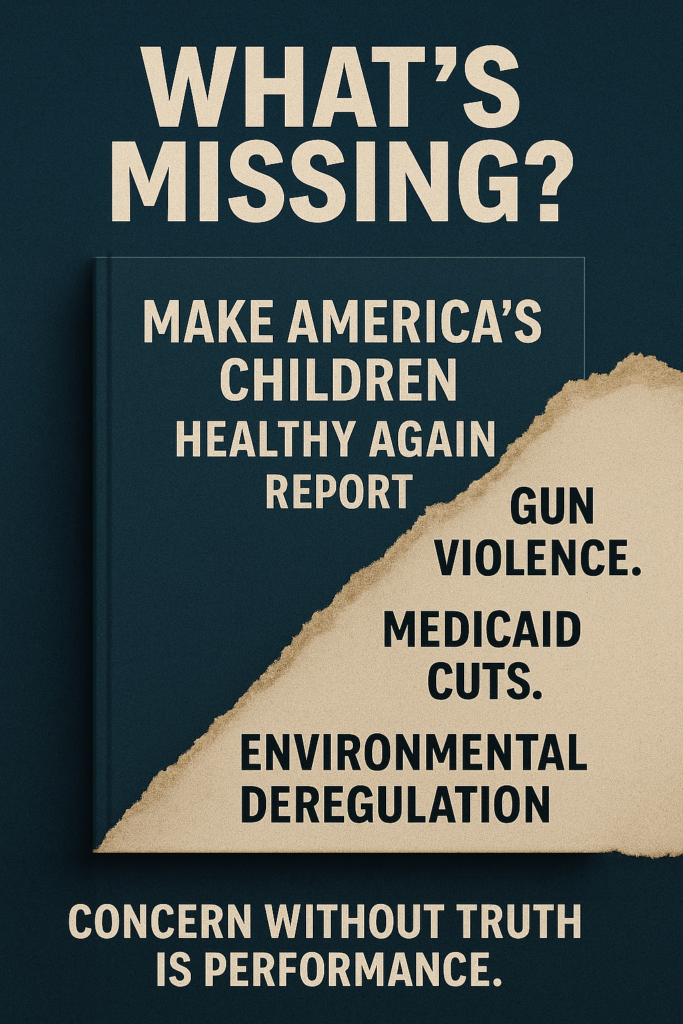What’s missing, what’s misleading, and why we should be skeptical.
A new federal report was released this month with the title: “Make America’s Children Healthy Again” (MAHA).
It’s a big swing. And at first glance, it seems like something I should welcome.
It talks about the rise of chronic illness.
It shines a light on ultra-processed food, environmental toxins, overmedication, and lack of movement in kids.
It even suggests that our medical system has become too quick to prescribe, and too slow to ask why so many children are getting sick.
There’s a lot in there that I agree with.
But also – a lot that’s missing.
And some that feels less like concern, and more like performance.

What the MAHA Report Gets Right
To be clear, the report isn’t wrong about everything.
Our kids are facing a health crisis. Rates of autism, ADHD, anxiety, diabetes, and obesity have all climbed dramatically. And yes – our food system, our screen culture, and our over-reliance on pharmaceuticals all play a role.
The call for a more holistic, root-cause approach is long overdue.
Families like mine have been saying that for years.
But…
What’s Glaringly Absent
For a report that claims to care about children’s health, one of the most devastating truths is completely ignored:
Guns are now the leading cause of death for American children and teens.
In 2020 alone, 4,300 kids died from firearms.
That’s the equivalent of one Boeing 747 crash every month for nine months.
If any other threat were causing this kind of loss – if it were a virus, a food additive, or a malfunctioning car seat – there would be a national outcry.
But because it’s guns? The report says nothing.
No mention. No recommendations.
Just silence.
That’s not just a missed opportunity. It’s a deliberate choice.
And it tells you everything you need to know about where this report’s priorities really lie.
What About Hunger? The Report’s Silence on Food Insecurity
There’s another glaring omission in the MAHA report:
No serious mention of food insecurity.
You can’t write a report about children’s health
and fail to address the fact that over 13 million kids in the U.S. live in food-insecure households.
That’s not a fringe issue.
That’s a national emergency.
A food desert is an area—often urban or rural—where families have limited or no access to affordable, nutritious food.
Millions of Americans – disproportionately low-income and communities of color – live in these zones.
So when a report blames kids’ diets without addressing food deserts, it’s not just incomplete.
It’s ignorant of reality.
The Healthcare Crisis the MAHA Report Won’t Touch
The report also fails to mention another truth:
Millions of American families don’t have consistent access to healthcare.
- Medicaid expansion is under attack.
- Children’s health insurance (CHIP) remains underfunded in many states.
- Families with disabled children face constant red tape, denials, and waitlists.
- Mental health services are scarce and under-resourced.
A report that claims to care about children’s health and says nothing about access to healthcare isn’t just incomplete.
It’s dishonest.
Let’s Be Clear About Who’s Undermining Care
We can’t keep talking about “government failures” without naming names.
The Republican Party has spent more than a decade trying to dismantle the Affordable Care Act – and with it, access to healthcare for millions of families.
They’ve blocked Medicaid expansion.
They’ve pushed policies that defund critical support services.
And they just passed a budget that guts programs for the most vulnerable, including children with disabilities and chronic illnesses.
So when a GOP-led commission releases a report about children’s health?
Forgive me if I don’t see it as a turning point.
It looks more like a political distraction – a way to shift blame while the real systems of care are dismantled behind the scenes.
Why the Emphasis on Vaccines Feels Like a Distraction
Instead of addressing the full scope of threats facing children, the MAHA report leans heavily into vaccine skepticism.
Not just around safety, but around timing, frequency, and long-term effects.
I’m not someone who blindly accepts medical narratives.
I’ve asked hard questions about regression, immune vulnerability, and the rise in complex neurodevelopmental conditions.
I believe in transparency, and I believe in nuance.
But when a government report places its heaviest emphasis on vaccines – while ignoring food insecurity, gun violence, environmental deregulation, and healthcare collapse – it starts to feel less like health policy and more like political bait.
The vaccine debate is already deeply polarizing.
The more it dominates the conversation, the easier it becomes to ignore the real systems that are making children sick.
Final Thoughts: Reports Aren’t Enough
Even if parts of the MAHA report are right, the bigger issue is credibility.
This administration has empowered the very systems that are failing our kids.
You can’t dismantle Medicaid, gut protections, and ignore gun violence – then turn around and tell us you’re the ones who care.
You’re not.
If we really want to make America’s children healthy again, we need to do more than release reports.
We need to face the whole truth.
We need to name the real threats.
And we need to stop mistaking performative concern for policy.
Because this isn’t about rhetoric.
It’s about the lives of children – and the systems that continue to fail them.
